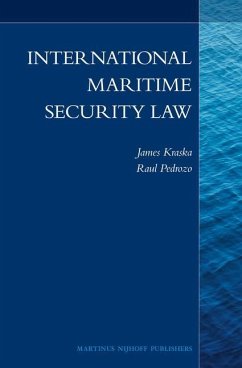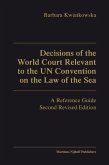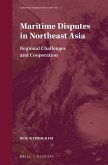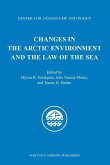- Gebundenes Buch
- Merkliste
- Auf die Merkliste
- Bewerten Bewerten
- Teilen
- Produkt teilen
- Produkterinnerung
- Produkterinnerung
International Maritime Security Law by James Kraska and Raul Pedrozo defines an emerging interdisciplinary field of law and policy comprised of norms, legal regimes, and rules to address today's hybrid threats to the global order of the oceans. Worldwide shipping commerce, fishing fleets, pleasure craft, and coastal states are exposed to the menace of offshore terrorism, weapons of mass destruction, piracy, smuggling, robbery, marine insurgency and anti-access threats. Land-based institutions and maritime constabulary forces operate within an increasingly integrated network that blends…mehr
Andere Kunden interessierten sich auch für
![Decisions of the World Court Relevant to the Un Convention on the Law of the Sea Decisions of the World Court Relevant to the Un Convention on the Law of the Sea]() Barbara KwiatkowskaDecisions of the World Court Relevant to the Un Convention on the Law of the Sea242,99 €
Barbara KwiatkowskaDecisions of the World Court Relevant to the Un Convention on the Law of the Sea242,99 €![The EU Maritime Safety Policy and International Law The EU Maritime Safety Policy and International Law]() Henrik RingbomThe EU Maritime Safety Policy and International Law366,99 €
Henrik RingbomThe EU Maritime Safety Policy and International Law366,99 €![The World Ocean in Globalisation The World Ocean in Globalisation]() The World Ocean in Globalisation318,99 €
The World Ocean in Globalisation318,99 €![Maritime Disputes in Northeast Asia Maritime Disputes in Northeast Asia]() Suk Kyoon KimMaritime Disputes in Northeast Asia170,99 €
Suk Kyoon KimMaritime Disputes in Northeast Asia170,99 €![Changes in the Arctic Environment and the Law of the Sea Changes in the Arctic Environment and the Law of the Sea]() Changes in the Arctic Environment and the Law of the Sea291,99 €
Changes in the Arctic Environment and the Law of the Sea291,99 €![The International Law of the Sea The International Law of the Sea]() Yoshifumi TanakaThe International Law of the Sea57,99 €
Yoshifumi TanakaThe International Law of the Sea57,99 €![The International Law of the Sea The International Law of the Sea]() Yoshifumi TanakaThe International Law of the Sea22,99 €
Yoshifumi TanakaThe International Law of the Sea22,99 €-
-
-
International Maritime Security Law by James Kraska and Raul Pedrozo defines an emerging interdisciplinary field of law and policy comprised of norms, legal regimes, and rules to address today's hybrid threats to the global order of the oceans. Worldwide shipping commerce, fishing fleets, pleasure craft, and coastal states are exposed to the menace of offshore terrorism, weapons of mass destruction, piracy, smuggling, robbery, marine insurgency and anti-access threats. Land-based institutions and maritime constabulary forces operate within an increasingly integrated network that blends elements of humanitarian law, human rights law, criminal law, and law of the sea, with inspection regimes, commercial enterprise, and marine safety and environmental stewardship. The new authorities fuse together a global maritime partnership among states, international organizations and commercial interests to protect the maritime commons from the most dangerous risks and hazards.
Hinweis: Dieser Artikel kann nur an eine deutsche Lieferadresse ausgeliefert werden.
Hinweis: Dieser Artikel kann nur an eine deutsche Lieferadresse ausgeliefert werden.
Produktdetails
- Produktdetails
- Verlag: Brill / Brill Nijhoff
- XXVI, 940 Pp. edition
- Seitenzahl: 968
- Erscheinungstermin: 19. April 2013
- Englisch
- Abmessung: 239mm x 163mm x 56mm
- Gewicht: 1604g
- ISBN-13: 9789004233560
- ISBN-10: 9004233563
- Artikelnr.: 37331005
- Herstellerkennzeichnung
- Libri GmbH
- Europaallee 1
- 36244 Bad Hersfeld
- 06621 890
- Verlag: Brill / Brill Nijhoff
- XXVI, 940 Pp. edition
- Seitenzahl: 968
- Erscheinungstermin: 19. April 2013
- Englisch
- Abmessung: 239mm x 163mm x 56mm
- Gewicht: 1604g
- ISBN-13: 9789004233560
- ISBN-10: 9004233563
- Artikelnr.: 37331005
- Herstellerkennzeichnung
- Libri GmbH
- Europaallee 1
- 36244 Bad Hersfeld
- 06621 890
James Kraska, LL.M. (2005), S.J.D. (2009), University of Virginia School of Law, is Howard S. Levie Professor in the Stockton Center for International Law at the U.S. Naval War College, and author of Maritime Power and Law of the Sea (Oxford, 2011). Raul Pedrozo, LL.M. (1993), Georgetown University Law Center, is a Non-resident Research Fellow in the Stockton Center for International Law at the U.S. Naval War College and a Deputy General for the Department of Defense.
Chapter 1: Introduction to Maritime Security Law
1.1. Introduction
1.2 What is Maritime Security Law?
1.3 Building a Public Order of the Oceans
1.4 Conclusion
Chapter 2: American Maritime Security Policy and Strategy
2.1 Introduction
2.2 U.S. Maritime Security Policy
2.3 National Strategy for Maritime Security
2.4 National Strategy for Global Supply Chain Security
2.5 U.S. Maritime Strategy for Homeland Security
2.6 Cooperative Strategy for 21st Century Sea Power
Chapter 3: European Maritime Strategy and Policy
3.I North Atlantic Treaty Organization
3.2 European Union
3.3 Chiefs of European Navies Maritime Operational Concept
3.4 U.K. Future Maritime Operational Concept
Chapter 4: Peacetime Zones and Control Measures
4.I Temporary Suspension of Innocent Passage
4.2 Offshore Installation Safety Zones
4.3 World-Wide Navigational Warning Service
4.4 Aeronautical Information Services
Chapter 5: Marine Environmental Protection and Control Measures
5.1 The Marine Environment
5.2 Particularly Sensitive Sea Areas
5.3 Ships' Routeing, Vessel Traffic Services, and Ships' Reporting
5.4 Mandatory Ship Reporting (United States)
5.5 Marine Mammals
Chapter 6: U.S. Safety and Security Zones and Airspace Control Measures
6.1 Introduction to U.S. Zones
6.2 Jurisdiction over the Navigable Waters of the United States
6.3 Safety Zones
6.4 Security Zones
Chapter 7: Sea Power, Grand Strategy, and Freedom of the Seas
7.1 Seapower and Grand Strategy
7.2 U.S. Freedom of Navigation Program
Annex 1: National Security Decision Directive 20 (1982)
Annex 2: National Security Decision Directive 265 (1987)
Annex 3: National Security Directive 49 (1990)
Annex 4: Presidential Decision Directive 32 (1995)
Annex 5: U.S. Freedom of Navigation Challenges 1995-2003
Chapter 8: Freedom of Navigation in the Law of the Sea
8.1 Baselines
8.2 Internal Waters
8.3 Territorial Sea
8.4 Straits Used for International Navigation
8.5 Contiguous Zone
8.6 Exclusive Economic Zone
8.7 Continental Shelf
8.8 High Seas
Chapter 9: Excessive Maritime Claims: Territorial Seas, Straits, and Archipelagos
9.1 Introduction
9.2 Illegal Straight Baselines
9.2.1 Libya's "Line of Death" in the Gulf of Sirte
9.3 Excessive Claims over the Territorial Sea and Contiguous Zone
9.4 Excessive Claims over Straits Used for International Navigation
9.5 Excessive Claims over Archipelagic Sea Lanes
Chapter 10: Security Claims in the Exclusive Economic Zone
10.1 Security Claims in the Exclusive Economic Zone
10.2 China's Oceans Law and the EEZ
10.3 North Korea's Military Zone
10.4 Military Activities in the EEZ
Chapter 11: Flashpoint: South China Sea
11.1 The Political Seascape and Regional Stability
11.2 American Security Relationships and the South China Sea
Chapter 12: Securing the Marine Transportation System
12.1 Threats to International Ship and Port Facility Security
12.2 The Law of the Sea and the IMO
12.3 Exclusive Flag State Jurisdiction
12.4 The ISPS Code
12.5 Maritime Domain Awareness
Chapter 13: Port and Port Facility Security
13.1 Ports in the Global Transportation System
13.2 Port State Control
13.3 Port Facility Security
13.4 Port State Control Certifications and Documents
13.5 Questionnaire for Designated Authorities
13.6 Security Checklist for Port Facility Operators
Chapter 14: Ship and Ship Operator Security
14.1 Shipping Company Responsibilities
14.2 Checklist for Shipping Companies
14.3 Ship Security
14.4 Checklist for Ship Security Personnel
14.5 Yachts and other Non-SOLAS vessels
Chapter 15: Global Authorities to Counter Drug Trafficking
15.1. International Law and the Trade in Illegal Drugs
15.2 The Multilateral Treaty Framework
15.3 International Maritime Organization
15.4 UN Basic Principles on the Use of Force
Chapter 16: Regional Authorities to Counter Drug Trafficking
16.1. Regional Cooperation in Countering Maritime Drug Trafficking
16.2 Caribbean Regional Maritime Agreement
16.3 Caribbean Basin Security Initiative
16.4 Organization of American States Model Operating Procedure
16.5 The Paris Pact Initiative
16.6 Republic of the Philippines National Coast Watch System
16.7 Mérida Initiative
16.8 The Central America Regional Security Initiative
Chapter 17: U.S. Maritime Counterdrug Law
17.1 Maritime Drug Law Enforcement Act
17.2 Drug Trafficking Vessel Interdiction Act
17.3 Foreign Narcotics Kingpin Designation Act
17.4 U. S. Coast Guard Authorities
17.5 Department of Defense Legal Authorities
Chapter 18: U.S. International Maritime Counterdrug Policy
18.1 The U.S. Policy and Operational Framework
18.2 U.S. Bilateral Maritime Counterdrug Instruments
18.3 Conclusion
18.4 U.S. Maritime Law Enforcement Instruments
Chapter 19: Migrant Smuggling at Sea
19.1 Transnational Threat of Irregular Migration
19.2 Law of the Sea Convention
19.3 Transnational Organized Crime Convention
19.4 Migrant Smuggling Protocol
19.5 IMO Initiatives
19.6 Duty to Assist
19.7 Salvage Conventions
19.8 International Convention for the Safety of Life at Sea
19.9 International Convention on Maritime Search and Rescue
19.10 Refugee Convention
19.11 The U.S. Experience in Law and Practice
19.12 Conclusion
Chapter 20: Maritime Piracy and Armed Robbery at Sea
20.1 The Historical Roots of the Law of Piracy
20.2 Contemporary Law of Maritime Piracy
20.3 Counter-piracy Operations
Chapter 21: Maritime Terrorism and Weapons of Mass Destruction at Sea
21.1 Prevalence of Maritime Terrorism
21.2 Non Proliferation Treaty
21.3 Coastal State and Flag State Jurisdiction
21.4 Cases on the Use of Force in Shipboarding
21.5 UN Security Council
21.6 Proliferation Security Initiative
21.7 Can the NPT Survive?
Chapter 22: Commentary on the Convention on the Suppression of Unlawful Acts against the Safety of Maritime Navigation
22.1 Convention on the Suppression of Unlawful Acts (SUA)
22.2 2005 Convention
22.3 2005 Protocol (Safety of Fixed Platforms)
Chapter 23: Irregular Naval Warfare and Blockade
23.1 Irregular Naval Warfare
23.2 Quarantine
23.3 Cordon Sanitaire
23.4 Neutrality and Maritime Blockade
23.5 Blockade in Non-International Armed Conflict
Chapter 24: Security Council Maritime Enforcement
24.1 Rhodesia Sanctions and the Beira Patrol (1965)
24.2 The Maritime Blockade of Iraq (1990-91)
24.3 Former Republic of Yugoslavia Armaments Embargo (1991-96)
24.4 Haiti Sanctions (1994)
24.5 Libya Embargo (2011)
Index
1.1. Introduction
1.2 What is Maritime Security Law?
1.3 Building a Public Order of the Oceans
1.4 Conclusion
Chapter 2: American Maritime Security Policy and Strategy
2.1 Introduction
2.2 U.S. Maritime Security Policy
2.3 National Strategy for Maritime Security
2.4 National Strategy for Global Supply Chain Security
2.5 U.S. Maritime Strategy for Homeland Security
2.6 Cooperative Strategy for 21st Century Sea Power
Chapter 3: European Maritime Strategy and Policy
3.I North Atlantic Treaty Organization
3.2 European Union
3.3 Chiefs of European Navies Maritime Operational Concept
3.4 U.K. Future Maritime Operational Concept
Chapter 4: Peacetime Zones and Control Measures
4.I Temporary Suspension of Innocent Passage
4.2 Offshore Installation Safety Zones
4.3 World-Wide Navigational Warning Service
4.4 Aeronautical Information Services
Chapter 5: Marine Environmental Protection and Control Measures
5.1 The Marine Environment
5.2 Particularly Sensitive Sea Areas
5.3 Ships' Routeing, Vessel Traffic Services, and Ships' Reporting
5.4 Mandatory Ship Reporting (United States)
5.5 Marine Mammals
Chapter 6: U.S. Safety and Security Zones and Airspace Control Measures
6.1 Introduction to U.S. Zones
6.2 Jurisdiction over the Navigable Waters of the United States
6.3 Safety Zones
6.4 Security Zones
Chapter 7: Sea Power, Grand Strategy, and Freedom of the Seas
7.1 Seapower and Grand Strategy
7.2 U.S. Freedom of Navigation Program
Annex 1: National Security Decision Directive 20 (1982)
Annex 2: National Security Decision Directive 265 (1987)
Annex 3: National Security Directive 49 (1990)
Annex 4: Presidential Decision Directive 32 (1995)
Annex 5: U.S. Freedom of Navigation Challenges 1995-2003
Chapter 8: Freedom of Navigation in the Law of the Sea
8.1 Baselines
8.2 Internal Waters
8.3 Territorial Sea
8.4 Straits Used for International Navigation
8.5 Contiguous Zone
8.6 Exclusive Economic Zone
8.7 Continental Shelf
8.8 High Seas
Chapter 9: Excessive Maritime Claims: Territorial Seas, Straits, and Archipelagos
9.1 Introduction
9.2 Illegal Straight Baselines
9.2.1 Libya's "Line of Death" in the Gulf of Sirte
9.3 Excessive Claims over the Territorial Sea and Contiguous Zone
9.4 Excessive Claims over Straits Used for International Navigation
9.5 Excessive Claims over Archipelagic Sea Lanes
Chapter 10: Security Claims in the Exclusive Economic Zone
10.1 Security Claims in the Exclusive Economic Zone
10.2 China's Oceans Law and the EEZ
10.3 North Korea's Military Zone
10.4 Military Activities in the EEZ
Chapter 11: Flashpoint: South China Sea
11.1 The Political Seascape and Regional Stability
11.2 American Security Relationships and the South China Sea
Chapter 12: Securing the Marine Transportation System
12.1 Threats to International Ship and Port Facility Security
12.2 The Law of the Sea and the IMO
12.3 Exclusive Flag State Jurisdiction
12.4 The ISPS Code
12.5 Maritime Domain Awareness
Chapter 13: Port and Port Facility Security
13.1 Ports in the Global Transportation System
13.2 Port State Control
13.3 Port Facility Security
13.4 Port State Control Certifications and Documents
13.5 Questionnaire for Designated Authorities
13.6 Security Checklist for Port Facility Operators
Chapter 14: Ship and Ship Operator Security
14.1 Shipping Company Responsibilities
14.2 Checklist for Shipping Companies
14.3 Ship Security
14.4 Checklist for Ship Security Personnel
14.5 Yachts and other Non-SOLAS vessels
Chapter 15: Global Authorities to Counter Drug Trafficking
15.1. International Law and the Trade in Illegal Drugs
15.2 The Multilateral Treaty Framework
15.3 International Maritime Organization
15.4 UN Basic Principles on the Use of Force
Chapter 16: Regional Authorities to Counter Drug Trafficking
16.1. Regional Cooperation in Countering Maritime Drug Trafficking
16.2 Caribbean Regional Maritime Agreement
16.3 Caribbean Basin Security Initiative
16.4 Organization of American States Model Operating Procedure
16.5 The Paris Pact Initiative
16.6 Republic of the Philippines National Coast Watch System
16.7 Mérida Initiative
16.8 The Central America Regional Security Initiative
Chapter 17: U.S. Maritime Counterdrug Law
17.1 Maritime Drug Law Enforcement Act
17.2 Drug Trafficking Vessel Interdiction Act
17.3 Foreign Narcotics Kingpin Designation Act
17.4 U. S. Coast Guard Authorities
17.5 Department of Defense Legal Authorities
Chapter 18: U.S. International Maritime Counterdrug Policy
18.1 The U.S. Policy and Operational Framework
18.2 U.S. Bilateral Maritime Counterdrug Instruments
18.3 Conclusion
18.4 U.S. Maritime Law Enforcement Instruments
Chapter 19: Migrant Smuggling at Sea
19.1 Transnational Threat of Irregular Migration
19.2 Law of the Sea Convention
19.3 Transnational Organized Crime Convention
19.4 Migrant Smuggling Protocol
19.5 IMO Initiatives
19.6 Duty to Assist
19.7 Salvage Conventions
19.8 International Convention for the Safety of Life at Sea
19.9 International Convention on Maritime Search and Rescue
19.10 Refugee Convention
19.11 The U.S. Experience in Law and Practice
19.12 Conclusion
Chapter 20: Maritime Piracy and Armed Robbery at Sea
20.1 The Historical Roots of the Law of Piracy
20.2 Contemporary Law of Maritime Piracy
20.3 Counter-piracy Operations
Chapter 21: Maritime Terrorism and Weapons of Mass Destruction at Sea
21.1 Prevalence of Maritime Terrorism
21.2 Non Proliferation Treaty
21.3 Coastal State and Flag State Jurisdiction
21.4 Cases on the Use of Force in Shipboarding
21.5 UN Security Council
21.6 Proliferation Security Initiative
21.7 Can the NPT Survive?
Chapter 22: Commentary on the Convention on the Suppression of Unlawful Acts against the Safety of Maritime Navigation
22.1 Convention on the Suppression of Unlawful Acts (SUA)
22.2 2005 Convention
22.3 2005 Protocol (Safety of Fixed Platforms)
Chapter 23: Irregular Naval Warfare and Blockade
23.1 Irregular Naval Warfare
23.2 Quarantine
23.3 Cordon Sanitaire
23.4 Neutrality and Maritime Blockade
23.5 Blockade in Non-International Armed Conflict
Chapter 24: Security Council Maritime Enforcement
24.1 Rhodesia Sanctions and the Beira Patrol (1965)
24.2 The Maritime Blockade of Iraq (1990-91)
24.3 Former Republic of Yugoslavia Armaments Embargo (1991-96)
24.4 Haiti Sanctions (1994)
24.5 Libya Embargo (2011)
Index
Chapter 1: Introduction to Maritime Security Law
1.1. Introduction
1.2 What is Maritime Security Law?
1.3 Building a Public Order of the Oceans
1.4 Conclusion
Chapter 2: American Maritime Security Policy and Strategy
2.1 Introduction
2.2 U.S. Maritime Security Policy
2.3 National Strategy for Maritime Security
2.4 National Strategy for Global Supply Chain Security
2.5 U.S. Maritime Strategy for Homeland Security
2.6 Cooperative Strategy for 21st Century Sea Power
Chapter 3: European Maritime Strategy and Policy
3.I North Atlantic Treaty Organization
3.2 European Union
3.3 Chiefs of European Navies Maritime Operational Concept
3.4 U.K. Future Maritime Operational Concept
Chapter 4: Peacetime Zones and Control Measures
4.I Temporary Suspension of Innocent Passage
4.2 Offshore Installation Safety Zones
4.3 World-Wide Navigational Warning Service
4.4 Aeronautical Information Services
Chapter 5: Marine Environmental Protection and Control Measures
5.1 The Marine Environment
5.2 Particularly Sensitive Sea Areas
5.3 Ships' Routeing, Vessel Traffic Services, and Ships' Reporting
5.4 Mandatory Ship Reporting (United States)
5.5 Marine Mammals
Chapter 6: U.S. Safety and Security Zones and Airspace Control Measures
6.1 Introduction to U.S. Zones
6.2 Jurisdiction over the Navigable Waters of the United States
6.3 Safety Zones
6.4 Security Zones
Chapter 7: Sea Power, Grand Strategy, and Freedom of the Seas
7.1 Seapower and Grand Strategy
7.2 U.S. Freedom of Navigation Program
Annex 1: National Security Decision Directive 20 (1982)
Annex 2: National Security Decision Directive 265 (1987)
Annex 3: National Security Directive 49 (1990)
Annex 4: Presidential Decision Directive 32 (1995)
Annex 5: U.S. Freedom of Navigation Challenges 1995-2003
Chapter 8: Freedom of Navigation in the Law of the Sea
8.1 Baselines
8.2 Internal Waters
8.3 Territorial Sea
8.4 Straits Used for International Navigation
8.5 Contiguous Zone
8.6 Exclusive Economic Zone
8.7 Continental Shelf
8.8 High Seas
Chapter 9: Excessive Maritime Claims: Territorial Seas, Straits, and Archipelagos
9.1 Introduction
9.2 Illegal Straight Baselines
9.2.1 Libya's "Line of Death" in the Gulf of Sirte
9.3 Excessive Claims over the Territorial Sea and Contiguous Zone
9.4 Excessive Claims over Straits Used for International Navigation
9.5 Excessive Claims over Archipelagic Sea Lanes
Chapter 10: Security Claims in the Exclusive Economic Zone
10.1 Security Claims in the Exclusive Economic Zone
10.2 China's Oceans Law and the EEZ
10.3 North Korea's Military Zone
10.4 Military Activities in the EEZ
Chapter 11: Flashpoint: South China Sea
11.1 The Political Seascape and Regional Stability
11.2 American Security Relationships and the South China Sea
Chapter 12: Securing the Marine Transportation System
12.1 Threats to International Ship and Port Facility Security
12.2 The Law of the Sea and the IMO
12.3 Exclusive Flag State Jurisdiction
12.4 The ISPS Code
12.5 Maritime Domain Awareness
Chapter 13: Port and Port Facility Security
13.1 Ports in the Global Transportation System
13.2 Port State Control
13.3 Port Facility Security
13.4 Port State Control Certifications and Documents
13.5 Questionnaire for Designated Authorities
13.6 Security Checklist for Port Facility Operators
Chapter 14: Ship and Ship Operator Security
14.1 Shipping Company Responsibilities
14.2 Checklist for Shipping Companies
14.3 Ship Security
14.4 Checklist for Ship Security Personnel
14.5 Yachts and other Non-SOLAS vessels
Chapter 15: Global Authorities to Counter Drug Trafficking
15.1. International Law and the Trade in Illegal Drugs
15.2 The Multilateral Treaty Framework
15.3 International Maritime Organization
15.4 UN Basic Principles on the Use of Force
Chapter 16: Regional Authorities to Counter Drug Trafficking
16.1. Regional Cooperation in Countering Maritime Drug Trafficking
16.2 Caribbean Regional Maritime Agreement
16.3 Caribbean Basin Security Initiative
16.4 Organization of American States Model Operating Procedure
16.5 The Paris Pact Initiative
16.6 Republic of the Philippines National Coast Watch System
16.7 Mérida Initiative
16.8 The Central America Regional Security Initiative
Chapter 17: U.S. Maritime Counterdrug Law
17.1 Maritime Drug Law Enforcement Act
17.2 Drug Trafficking Vessel Interdiction Act
17.3 Foreign Narcotics Kingpin Designation Act
17.4 U. S. Coast Guard Authorities
17.5 Department of Defense Legal Authorities
Chapter 18: U.S. International Maritime Counterdrug Policy
18.1 The U.S. Policy and Operational Framework
18.2 U.S. Bilateral Maritime Counterdrug Instruments
18.3 Conclusion
18.4 U.S. Maritime Law Enforcement Instruments
Chapter 19: Migrant Smuggling at Sea
19.1 Transnational Threat of Irregular Migration
19.2 Law of the Sea Convention
19.3 Transnational Organized Crime Convention
19.4 Migrant Smuggling Protocol
19.5 IMO Initiatives
19.6 Duty to Assist
19.7 Salvage Conventions
19.8 International Convention for the Safety of Life at Sea
19.9 International Convention on Maritime Search and Rescue
19.10 Refugee Convention
19.11 The U.S. Experience in Law and Practice
19.12 Conclusion
Chapter 20: Maritime Piracy and Armed Robbery at Sea
20.1 The Historical Roots of the Law of Piracy
20.2 Contemporary Law of Maritime Piracy
20.3 Counter-piracy Operations
Chapter 21: Maritime Terrorism and Weapons of Mass Destruction at Sea
21.1 Prevalence of Maritime Terrorism
21.2 Non Proliferation Treaty
21.3 Coastal State and Flag State Jurisdiction
21.4 Cases on the Use of Force in Shipboarding
21.5 UN Security Council
21.6 Proliferation Security Initiative
21.7 Can the NPT Survive?
Chapter 22: Commentary on the Convention on the Suppression of Unlawful Acts against the Safety of Maritime Navigation
22.1 Convention on the Suppression of Unlawful Acts (SUA)
22.2 2005 Convention
22.3 2005 Protocol (Safety of Fixed Platforms)
Chapter 23: Irregular Naval Warfare and Blockade
23.1 Irregular Naval Warfare
23.2 Quarantine
23.3 Cordon Sanitaire
23.4 Neutrality and Maritime Blockade
23.5 Blockade in Non-International Armed Conflict
Chapter 24: Security Council Maritime Enforcement
24.1 Rhodesia Sanctions and the Beira Patrol (1965)
24.2 The Maritime Blockade of Iraq (1990-91)
24.3 Former Republic of Yugoslavia Armaments Embargo (1991-96)
24.4 Haiti Sanctions (1994)
24.5 Libya Embargo (2011)
Index
1.1. Introduction
1.2 What is Maritime Security Law?
1.3 Building a Public Order of the Oceans
1.4 Conclusion
Chapter 2: American Maritime Security Policy and Strategy
2.1 Introduction
2.2 U.S. Maritime Security Policy
2.3 National Strategy for Maritime Security
2.4 National Strategy for Global Supply Chain Security
2.5 U.S. Maritime Strategy for Homeland Security
2.6 Cooperative Strategy for 21st Century Sea Power
Chapter 3: European Maritime Strategy and Policy
3.I North Atlantic Treaty Organization
3.2 European Union
3.3 Chiefs of European Navies Maritime Operational Concept
3.4 U.K. Future Maritime Operational Concept
Chapter 4: Peacetime Zones and Control Measures
4.I Temporary Suspension of Innocent Passage
4.2 Offshore Installation Safety Zones
4.3 World-Wide Navigational Warning Service
4.4 Aeronautical Information Services
Chapter 5: Marine Environmental Protection and Control Measures
5.1 The Marine Environment
5.2 Particularly Sensitive Sea Areas
5.3 Ships' Routeing, Vessel Traffic Services, and Ships' Reporting
5.4 Mandatory Ship Reporting (United States)
5.5 Marine Mammals
Chapter 6: U.S. Safety and Security Zones and Airspace Control Measures
6.1 Introduction to U.S. Zones
6.2 Jurisdiction over the Navigable Waters of the United States
6.3 Safety Zones
6.4 Security Zones
Chapter 7: Sea Power, Grand Strategy, and Freedom of the Seas
7.1 Seapower and Grand Strategy
7.2 U.S. Freedom of Navigation Program
Annex 1: National Security Decision Directive 20 (1982)
Annex 2: National Security Decision Directive 265 (1987)
Annex 3: National Security Directive 49 (1990)
Annex 4: Presidential Decision Directive 32 (1995)
Annex 5: U.S. Freedom of Navigation Challenges 1995-2003
Chapter 8: Freedom of Navigation in the Law of the Sea
8.1 Baselines
8.2 Internal Waters
8.3 Territorial Sea
8.4 Straits Used for International Navigation
8.5 Contiguous Zone
8.6 Exclusive Economic Zone
8.7 Continental Shelf
8.8 High Seas
Chapter 9: Excessive Maritime Claims: Territorial Seas, Straits, and Archipelagos
9.1 Introduction
9.2 Illegal Straight Baselines
9.2.1 Libya's "Line of Death" in the Gulf of Sirte
9.3 Excessive Claims over the Territorial Sea and Contiguous Zone
9.4 Excessive Claims over Straits Used for International Navigation
9.5 Excessive Claims over Archipelagic Sea Lanes
Chapter 10: Security Claims in the Exclusive Economic Zone
10.1 Security Claims in the Exclusive Economic Zone
10.2 China's Oceans Law and the EEZ
10.3 North Korea's Military Zone
10.4 Military Activities in the EEZ
Chapter 11: Flashpoint: South China Sea
11.1 The Political Seascape and Regional Stability
11.2 American Security Relationships and the South China Sea
Chapter 12: Securing the Marine Transportation System
12.1 Threats to International Ship and Port Facility Security
12.2 The Law of the Sea and the IMO
12.3 Exclusive Flag State Jurisdiction
12.4 The ISPS Code
12.5 Maritime Domain Awareness
Chapter 13: Port and Port Facility Security
13.1 Ports in the Global Transportation System
13.2 Port State Control
13.3 Port Facility Security
13.4 Port State Control Certifications and Documents
13.5 Questionnaire for Designated Authorities
13.6 Security Checklist for Port Facility Operators
Chapter 14: Ship and Ship Operator Security
14.1 Shipping Company Responsibilities
14.2 Checklist for Shipping Companies
14.3 Ship Security
14.4 Checklist for Ship Security Personnel
14.5 Yachts and other Non-SOLAS vessels
Chapter 15: Global Authorities to Counter Drug Trafficking
15.1. International Law and the Trade in Illegal Drugs
15.2 The Multilateral Treaty Framework
15.3 International Maritime Organization
15.4 UN Basic Principles on the Use of Force
Chapter 16: Regional Authorities to Counter Drug Trafficking
16.1. Regional Cooperation in Countering Maritime Drug Trafficking
16.2 Caribbean Regional Maritime Agreement
16.3 Caribbean Basin Security Initiative
16.4 Organization of American States Model Operating Procedure
16.5 The Paris Pact Initiative
16.6 Republic of the Philippines National Coast Watch System
16.7 Mérida Initiative
16.8 The Central America Regional Security Initiative
Chapter 17: U.S. Maritime Counterdrug Law
17.1 Maritime Drug Law Enforcement Act
17.2 Drug Trafficking Vessel Interdiction Act
17.3 Foreign Narcotics Kingpin Designation Act
17.4 U. S. Coast Guard Authorities
17.5 Department of Defense Legal Authorities
Chapter 18: U.S. International Maritime Counterdrug Policy
18.1 The U.S. Policy and Operational Framework
18.2 U.S. Bilateral Maritime Counterdrug Instruments
18.3 Conclusion
18.4 U.S. Maritime Law Enforcement Instruments
Chapter 19: Migrant Smuggling at Sea
19.1 Transnational Threat of Irregular Migration
19.2 Law of the Sea Convention
19.3 Transnational Organized Crime Convention
19.4 Migrant Smuggling Protocol
19.5 IMO Initiatives
19.6 Duty to Assist
19.7 Salvage Conventions
19.8 International Convention for the Safety of Life at Sea
19.9 International Convention on Maritime Search and Rescue
19.10 Refugee Convention
19.11 The U.S. Experience in Law and Practice
19.12 Conclusion
Chapter 20: Maritime Piracy and Armed Robbery at Sea
20.1 The Historical Roots of the Law of Piracy
20.2 Contemporary Law of Maritime Piracy
20.3 Counter-piracy Operations
Chapter 21: Maritime Terrorism and Weapons of Mass Destruction at Sea
21.1 Prevalence of Maritime Terrorism
21.2 Non Proliferation Treaty
21.3 Coastal State and Flag State Jurisdiction
21.4 Cases on the Use of Force in Shipboarding
21.5 UN Security Council
21.6 Proliferation Security Initiative
21.7 Can the NPT Survive?
Chapter 22: Commentary on the Convention on the Suppression of Unlawful Acts against the Safety of Maritime Navigation
22.1 Convention on the Suppression of Unlawful Acts (SUA)
22.2 2005 Convention
22.3 2005 Protocol (Safety of Fixed Platforms)
Chapter 23: Irregular Naval Warfare and Blockade
23.1 Irregular Naval Warfare
23.2 Quarantine
23.3 Cordon Sanitaire
23.4 Neutrality and Maritime Blockade
23.5 Blockade in Non-International Armed Conflict
Chapter 24: Security Council Maritime Enforcement
24.1 Rhodesia Sanctions and the Beira Patrol (1965)
24.2 The Maritime Blockade of Iraq (1990-91)
24.3 Former Republic of Yugoslavia Armaments Embargo (1991-96)
24.4 Haiti Sanctions (1994)
24.5 Libya Embargo (2011)
Index








